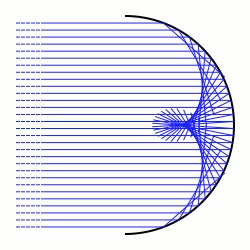Caustic (mathematics)
In differential geometry, a caustic is the envelope of rays either reflected or refracted by a manifold.The word caustic, in fact, comes from the Greek καυστός, burnt, via the Latin causticus, burning.A common situation where caustics are visible is when light shines on a drinking glass.The glass casts a shadow, but also produces a curved region of bright light.In ideal circumstances (including perfectly parallel rays, as if from a point source at infinity), a nephroid-shaped patch of light can be produced.[2][3] Rippling caustics are commonly formed when light shines through waves on a body of water.; the reflection of the direction vector is (normal needs special normalization) Having components of found reflected vector treat it as a tangent Using the simplest envelope form which may be unaesthetic, but; i.e., light entering a parabolic mirror parallel to its axis is reflected through the focus.

Caustic (disambiguation)circledifferential geometryenvelopereflectedrefractedmanifoldcausticsgeometric opticssymplectic geometrysingularity theorycritical value setLagrangian mappingsymplectic manifoldsubsetfibrationbase spacesunlightnephroidrainbowwavelengthsevoluteorthotomiclinear systemCramer's ruleparabolicCut locus (Riemannian manifold)Last geometric statement of JacobiNephroid causticArnold, V. I.Varchenko, A. N.Gusein-Zade, S. M.MathWorldWeisstein, Eric W.Unary operationsInvoluteDual curveInverse curveParallel curveIsopticPedal & Contrapedal curvesNegative pedal curvePursuit curveStrophoidBinary operationsRouletteCissoidOperations